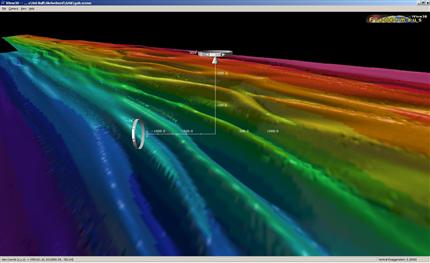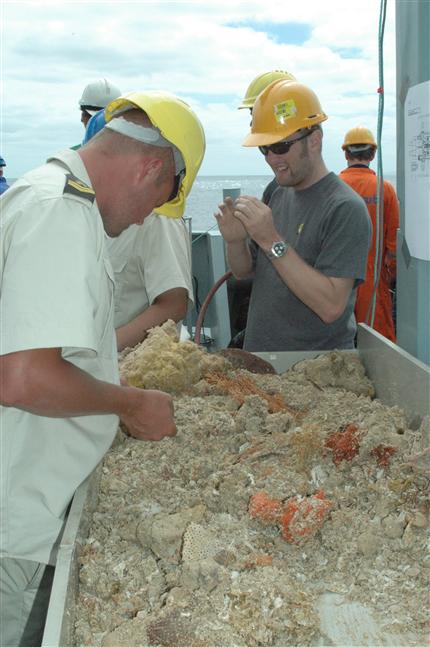Carbonate mounds in full colour, rare birds and ginger in abundanceNewsletter 17: Geological equipment has been fully deployed this week on board VÆDDEREN. We have heard plenty from our land based projects in the Solomon Islands, too.
Dato 4.12.2006
The Great Australian Bight of the south western coast of Australia contains carbonate mounds which are generally thought to have formed during ice ages by reef-building organisms, known as bryozoans or moss animals. There is however some doubt about the tenability of this explanation. Galathea 3 geologists, led by Associate Professor Mads Huuse, have performed a series of investigations and suggest another hypothesis: can the formation of the bank be due to sedimentation in connection with the powerful Leeuwin Current along the western and southern coasts?
The investigations were extensive, involving:
- Seismic profiling. This involves the transmission of acoustic energy that is reflected as a signal from the ocean floor and underlying layers. Pictures and information (in Danish) on VÆDDEREN’s hull-mounted advanced multi-beam equipment can be found at Jyllands-Posten’s Galathea web page.
- Core samples of the sea bed, taken by box or gravity corer, for example
- Hydrographical tests – measurement of currents
- Water sampling
- Filming of the conditions on the ocean floor by means of ROV (Remotely Operated Vehicle). A video clip of this and special adaptation of the corer involving a trouser leg can be seen at: Politiken

Carbonate mounds in Technicolor – data from the Great Australian Bight
Ongoing projects are also busy with CTD profiling and bottom trawling for life on the seabed. They are Roseobacter bacteria – the ocean’s stars, Alien matter and metals and The Marine Carbon Cycle.

Foto: Anne Sofie Berendt
Researchers and crew examine the haul from the sea bed
An island of rare birds
There is great progress within Galathea 3’s ornithological project on the Solomon Islands. Professor Jon Fjeldså of the Zoological Museum heads a team of six who are currently on the island of Makira. The project has a website (in Danish) detailing some of the extremely rare species of birds that the scientists hope to encounter on the islands. One example is the Tahiti petrel, only two examples of which have so far been collected, both in the straits between the Solomon Islands. (Click ‘Fuglestemmer’ for a link to 17 recordings of bird song in the Australasian region). Below is an entry from the Makira log – link to the website here.
1 December 2006. Makira is unique in terms of its bird population. The many kinds, each with very limited area of occupancy, make the island fascinating. There are more than 60 endemic species in the Solomon Islands, which is to say that they are not found anywhere else in the world. Ten of these are only found on Makira. The birds of this island are thus a mine of information on the way new species arise and may spread to other areas. We have collected blood samples of half of the birds that are unique to Makira. There is only one kind we have not yet seen: the Makira Moorhen (Gallinula silvestris, which was discovered and described in 1929 and has since then only infrequently been reported. The local hunters we have spoken with know this bird only from hearsay; one has to go several generations back to find someone who has seen it in the flesh. The Makira Moorhen is categorised as ‘critically endangered’ (according to Birdlife International/IUCN) and is possibly already extinct. Unfortunately, we cannot provide grounds for moving the species to a lower level of risk at the moment.
Ginger is many things
The botanicist Axel Dalberg Poulsen has also made exciting discoveries on Makira. He and Fred Pitisopa, a Solomon Islander, have so far documented 10 types of ginger on the island. All except one had local names. Further investigations will show whether these include any hitherto unknown species. Axel and Fred will continue their search for members of the ginger genus on Kolombangarra Island, where they arrive on 6 December. More can be found on this project by following this link.
Sustainable management of resources
Yet another land-based Galathea 3 project is active in the Solomon Islands. It bears the title Sustainable resource use or imminent collapse? Climate, livelihoods and production in the Southwest Pacific or CLIP. (Resources and survival in the South West Pacific – in Galathea’s list of projects). Associate Professor Ole Mertz of the Geographical Insitute at Copenhagen University oversees more than 30 Danish and local researchers and students in teams on three small islands: Bellona, Ontong Java and Tikopia.
The team on Bellona has been active for some weeks and first results are coming through. Pictures and link to the project logbook here.
Meanwhile, on the other side of the Australian continent, VÆDDEREN ploughs her course towards Tasmania, with expected arrival on Thursday morning 08.00 hours local time. The good ship shows signs, though humble, of the coming season’s spirit...

Foto: Anne Sofie Berendt
Christmas is coming for Galathea 3.
|